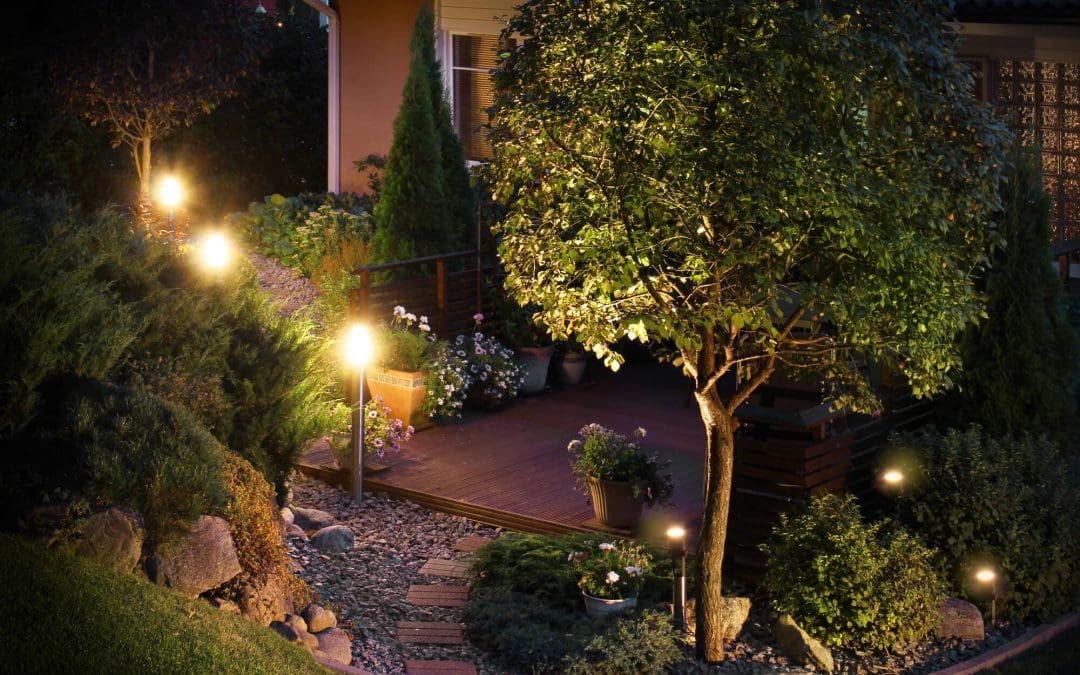Creating the perfect outdoor living space involves more than just comfortable furniture and beautiful landscaping; well-executed lighting can transform your backyard into a magical retreat after dark. Here’s how to effectively light your outdoor living spaces for functionality and ambiance.
Understanding the Basics of Outdoor Lighting
Before diving into specific lighting techniques, understand the basics of outdoor lighting. The primary goals are to enhance safety, security, and aesthetics. Different types of lights serve various purposes, such as task lighting for specific activities, ambient lighting for general illumination, and accent lighting to highlight features like plants or architectural details.
Focus on Functionality When You Light Outdoor Living Spaces
Task lighting is essential for areas where specific activities occur, such as cooking, dining, or reading. For outdoor kitchens or grills, consider installing bright, focused lights that allow you to see clearly while preparing food. Dining areas benefit from softer, downward-facing lights that illuminate the table without creating harsh glare. Pathways and steps should be well-lit to ensure safe navigation, using low-level lights that guide your way without overpowering the space.
Ambient Lighting: Setting the Mood
Ambient lighting provides overall illumination, creating a warm and inviting atmosphere. String lights are a popular choice for outdoor living spaces, offering a soft, festive glow. You can drape them across a pergola, hang them between trees, or line them along a fence. Lanterns and outdoor-rated chandeliers also add a touch of elegance and can be placed strategically to create a cohesive lighting plan.
Accent Lighting: Highlight Main Features When You Light Outdoor Living Spaces
Accent lighting draws attention to specific features of your outdoor space. Uplighting is an effective way to showcase trees, sculptures, or architectural elements, creating dramatic shadows and highlights. Use spotlights to focus on a water feature or flower bed. For a subtler effect, consider using downlighting to create a moonlit look, casting gentle light over pathways and gardens.
Choosing the Right Fixtures
Selecting the right fixtures is crucial for both aesthetics and functionality. When choosing outdoor lighting fixtures, ensure they are rated for outdoor use to withstand the elements. Consider the style of your home and outdoor decor; modern fixtures complement contemporary spaces, while vintage lanterns might be perfect for a more traditional setting. Energy-efficient options, such as LED lights, are ideal for reducing energy consumption and maintenance.
Installing and Maintaining Outdoor Lighting
Proper installation is critical to the longevity and effectiveness of your outdoor lighting. Solar-powered lights are an easy, eco-friendly option that doesn’t require wiring, while hardwired lights offer more reliable performance but may require professional installation. Regular maintenance, such as cleaning fixtures and replacing bulbs, ensures your lighting remains effective and attractive.
Smart Lighting Solutions
Incorporating smart technology into your outdoor lighting can enhance convenience and control. Smart lights can be controlled via smartphone apps, allowing you to adjust brightness, color, and scheduling from anywhere. Motion-sensor lights increase security by turning on automatically when movement is detected, deterring intruders and making it easier to navigate your outdoor space at night.
Creating Zones with When You Light Outdoor Living Spaces
Consider creating different lighting zones in your outdoor space to accommodate various activities and moods. A cozy seating area might benefit from softer, more intimate lighting, while a play area for children needs brighter, safer illumination. By layering different types of lighting, you can create a versatile and dynamic outdoor environment.
Proper lighting can enhance the functionality and beauty of your outdoor living spaces, making them enjoyable and usable year-round. By understanding the basics of outdoor lighting and strategically placing task, ambient, and accent lights, you can create a warm, inviting atmosphere that highlights the best features of your outdoor area. Choose the right fixtures, consider smart lighting options, and maintain your setup to ensure your outdoor space remains a well-lit haven for relaxation and entertainment.
FAQs
How can I prevent outdoor lights from attracting bugs?
To avoid attracting bugs, use LED lights with a warm color temperature (around 2700K to 3000K) and low UV output. These lights are less likely to attract insects than cooler, blue-toned lights. Consider using yellow “bug lights,” specifically designed to deter insects.
Are there any special considerations for lighting around pools or water features?
Lighting around pools or water features should be designed with safety in mind. Use low-voltage, waterproof lights with high IP ratings to prevent electrical hazards. Submersible lights can highlight the water’s movement and create a dramatic effect. Ensure all electrical components are properly grounded and installed by a professional.
What are the most durable materials for outdoor lighting fixtures?
Stainless steel, brass, copper, and cast aluminum are the most durable materials for outdoor lighting fixtures. These materials are resistant to rust and corrosion, making them ideal for withstanding the elements. Brass and copper can develop a natural patina over time, adding a unique character to your fixtures.
What is the benefit of using timers and photocells in outdoor lighting?
Timers and photocells automate outdoor lighting, saving energy and ensuring lights are on only when needed. Timers allow you to set specific times for lights to turn on and off, while photocells automatically adjust based on natural light levels, turning lights on at dusk and off at dawn. This automation adds convenience and helps reduce electricity costs.
Monadnock Home Inspections offers professional inspections to homebuyers and sellers in southern New Hampshire. Contact us to schedule our services.

